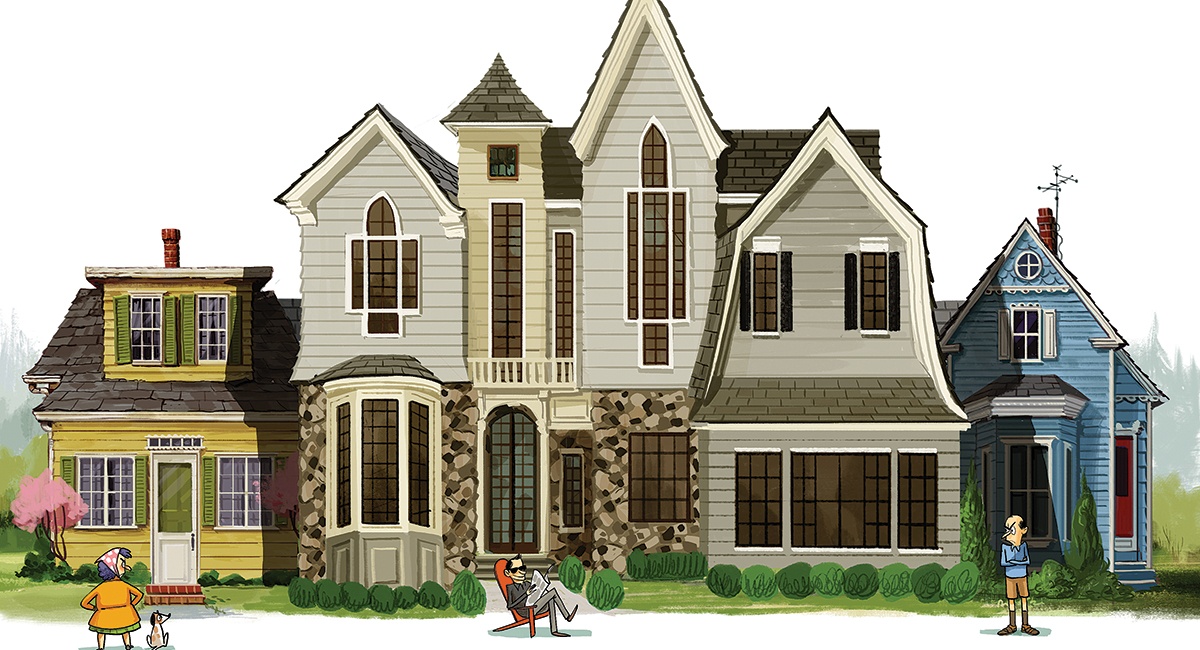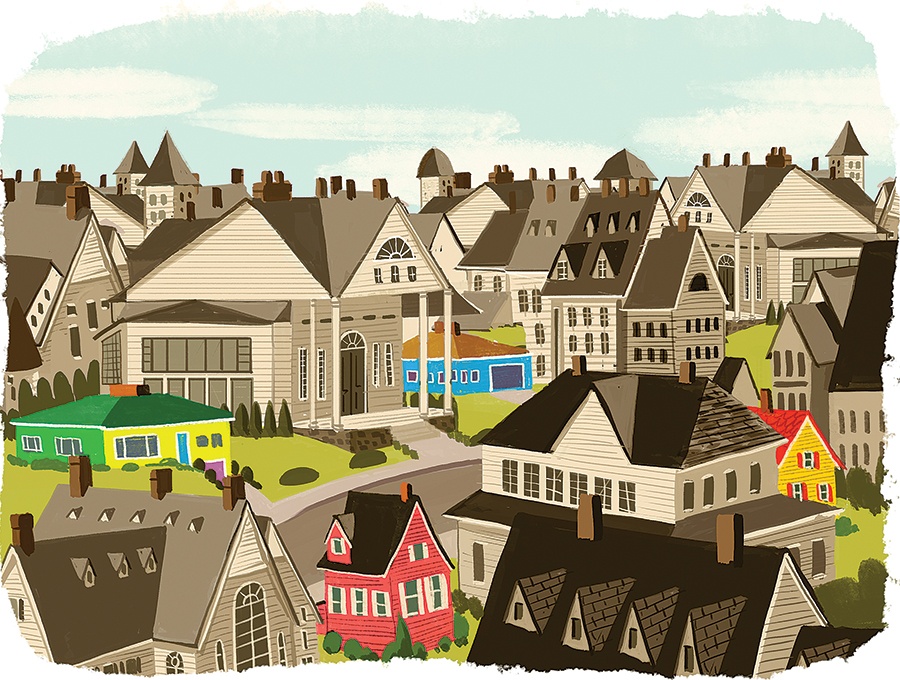The Teardown Wars Are Tearing Boston’s Suburbs Apart
Inside the knock-down, drag-out brawl for the soul of New England’s neighborhoods.

Illustration by Zohar Lazar
Nestled between the bucolic Minuteman Bikeway and busy Massachusetts Avenue, Byron Avenue in Lexington is a narrow little stretch you’d never find on your own. It’s not far from the historical town center and green, home to shops like the Crafty Yankee and Michelson’s Shoes, where generations of kids have been fitted for back-to-school sneakers. The Rockwellian storefronts stand alongside the Lexington Venue, one of the few area cinemas that hasn’t been upgraded with in-theater bar service and cushy seats.
A heavily wooded double cul-de-sac, Byron Avenue is dotted with modest bungalows. Wedged into the bushes, there’s a sign: Drive Like Your Kids Live Here. And at the very edge of the neighborhood, set back from the street, is a six-bedroom, five-bathroom modern farmhouse that dwarfs the others.
This was the home that led residents of quiet Byron Avenue to land court.
It all started four years ago, when neighbors got word that a house on Maple Street—which backs into the neighborhood—would be transformed from a ranch-style home into an expansive farmhouse-style new build. The plan came with a driveway that opened onto Byron. Because the existing home was part of the East Village Historic District, the proposed teardown triggered a town-approval meeting. By law, neighbors in the district were notified about the hearing, which would determine whether the new house conformed to historical standards.
From the start, the neighbors had a few concerns. For one, the 5,200-square-foot manse that the developer, well-known Lexington resident Michael Martignetti, sought to create on the lot was very different in character from the smaller homes around it. The proposal also required cutting down trees to make room for the driveway, which would forever change the neighborhood’s cloistered feel. Yet when the residents arrived at the Lexington Historical Commission’s hearing to voice their objections, “it appeared to us that all of the decisions had already been made,” says resident Donna Moultrup. “There was no reason for us to be there.”
Instead of thwarting the new home, town officials suggested that neighborhood residents meet with Martignetti (who declined to comment for this article) to discuss their concerns. He obliged, but the conversation was mainly about cosmetics, Moultrup says. Ultimately, the developer was given the go-ahead. That’s when things started getting ugly. Galvanized by a tight-knit community where friends borrow snowblowers and host neighborhood potlucks, locals pooled their money, lawyered up, and prepared to do battle.
Lexington, where a whopping 595 homes were torn down between 2010 and 2017, isn’t unique, of course. Cruise down any street in Newton, Wellesley, or Arlington, and you’ll undoubtedly spot these new houses, rising from tiny lots seemingly overnight—often sporting supersize garages, thick front-door pillars, faux stucco, and excessive dormers that make architects groan. Some are done better than others and blend in with the style of the neighborhood. But the ones that don’t stick out like a zit on prom night.

Illustration by Zohar Lazar
So why are we razing our suburban housing stock? As one builder explains it, “We have a land-supply issue. When people come from other parts of the country, they want a new house. They ask, ‘Where are your subdivisions? Where are all of your new houses?’” The answer? Potentially on the lot of an empty-nester’s old ranch or Cape. But as we tear down our past and rebuild the future, one sprawling McMansion at a time, some locals are increasingly asking if we’re also demolishing what makes us uniquely New England in the first place.
At their worst, teardowns pit neighbor against neighbor, sucking bank accounts dry with legal fees and making for rather uncomfortable interactions at the mailbox. In Marblehead, for instance, one couple took their neighbor to court over a 5,000-square-foot new build that blocked their water views. After a nearly two-decade-long legal battle—not to mention a very neighborly offer by the offending party to trade houses—the feud ironically ended with the man’s million-dollar teardown being torn down.
That’s the worst-case scenario. Typically, though, people know they need to get along. Says one Newton development activist, “I haven’t seen anyone sue their neighbor”—mostly because the neighbors aren’t usually the ones directly responsible for the demolition derby. “Ninety-nine percent of the time, it’s these house flippers, coming in, knocking down, and putting up a cardboard house in a matter of weeks and selling them for tremendous amounts of money. People don’t sue.”
Instead, they stew.
Interior designer Shannon Miranda grew up in Lexington. She bought her parents’ home in the Woodhaven section and rebuilt it in 1998 as what she describes as a 1,900-square-foot “eclectic Victorian.” At the time, she received blowback for putting up such a large abode for just two people. But today, compared with the nearly 5,000-square-foot Colonial-style builds she’s surrounded by, it feels downright humble. “You have people who work in town and can no longer buy in town,” she says. “Growing up, we had policemen, firemen, teachers, doctors, businesspeople. Now, some people can no longer afford to live here.” Children don’t play outside as much either, she says. “The houses are big, and air-conditioned, and kids stay inside.”
Next door in Arlington, many new buyers are referred to as “blow-ins” on town message boards, eyed with cynicism by natives who complain about the noise of construction, the outsize homes that tower over their neighbors, and the changing face of what was once a blue-collar community; recent missives on the town’s Facebook page describe the new homes as “monotonous and ugly.” Locals also criticize the selling process, in which developers approach potential sellers directly before a house even has the chance to go on the market, and turn it into a palace designed to attract well-heeled buyers interested in a low-maintenance, brand-new property.
Fed up with what they perceive to be the destruction of their towns’ unique characters, some concerned suburbanites have formed committees to raise awareness. Others turn to art: Former Newton resident Linda Marks, a mind-body psychotherapist, has set her woes to music. She chronicles what she calls the “teardown epidemic” with a catchy tune titled “Enough.” She released the song this fall and performed it at Harvard Square’s Club Passim on September 27:
Well, they’re tearing down the 1950s house I used to live in
And building two big houses on the lot
And the old town’s square’s transforming and the buildings are five stories
I guess commercial development is hot.
Marks, who’s designed artwork to accompany the song—featuring a bulldozer and a demolished home—calls the changes heartbreaking. “I raised my son on no child support in a multifamily house, and not in a big-bucks field. I cannot buy a house built [in Newton],” she says.
As locals’ cries to keep teardowns in check grow stronger, towns have taken notice. Arlington, for example, formed a study group in 2016 to recommend revisions to residential zoning bylaws for new construction on established streets. So far, the group has created construction-site regulations, including limiting hours that contractors can work so they don’t wake up the neighborhood. The town is also considering ways to tighten demolition laws for historical properties. On the whole, says Arlington town-meeting member Len Kardon, there might not be as many teardowns as in other ’burbs—but the lack of inventory makes every new home stand out. “It’s becoming more obvious,” he says, “because there are only so many houses that turn over a year in Arlington.”
Wellesley is undergoing a similar transformation, says architect Jan Gleysteen, who is part of the Wellesley Historical Commission. To address the issue, town officials met in 2017 and decided to require anyone seeking modifications on a dwelling built before 1950 to appear before a planning board to discuss preservation or restoration procedures first. The town also now requires a one-year waiting period before razing such a structure, with the goal of discouraging those simply hoping to make a quick buck on fast construction. One architect refers to the shoddy houses as “McBoxes”—where builders are simply “selling square footage.” One common trick? Including a built-out third floor with absolutely no purpose. Builders add the extra 800 or so square feet to make the cost per square foot look better, the architect says, but “it’s smoke and mirrors. It’s empty rooms. Empty boxes.”
For every preservationist or disgruntled neighbor, there are usually plenty of eager buyers who want new, large houses and are willing to pay top dollar to get them. As of press time, 46 single-family homes were on the market in Lexington. Of those, 16 were brand-new construction, says longtime Lexington Realtor Judy Moore. Many follow a specific pattern. “In some of the bigger houses, you will see two master bedrooms,” Moore says. “People are planning ahead. They want that first-floor bedroom for when they’ll need it, or if they have visiting parents to make it easier for them.”
Also on the punch list: first-floor offices, gyms, and media rooms—amenities a 1950s ranch-style home with small rooms just can’t provide. Realtors also say that many homes ripe for teardown have been occupied by elderly residents and haven’t been well maintained. Renovating them would cost more than simply razing them and starting anew. But with so much animosity from neighbors living in older abodes, what’s a deep-pocketed buyer in need of space to do? Many fear that they’ll be perceived as greedy interlopers: In fact, some people who approached me for this story asked to speak off the record for fear of retaliation by neighbors.

Illustration by Zohar Lazar
Vanessa, who requested that her last name not be used, had this in mind in May, when she and her husband bought a new-construction Colonial in Arlington Heights, an area once full of modest Cape-style houses. The neighborhood is transforming quickly, though, with densely packed streets such as George, Renfrew, and Wachusett full of shiny new homes that can sell for well over $1 million.
Vanessa and her husband wanted a house that was move-in ready in a neighborhood with a good school, so the four-bedroom, three-bath George Street residence down the block from the Dallin Elementary School fit the bill. But she was also aware of chatter among neighbors regarding the size of the property and what she paid. (“[It’s] a million-dollar home,” she says.) “We want to be good Arlington residents. Sometimes it’s a little bit hurtful,” she explains. “We’re just normal people moving in.”
To ward off tension, Vanessa and her husband make a conscious effort to meet the neighbors, often chatting while doing yard work or walking their dog. It helped that their house was at least a little smaller than some of the other new builds nearby, Vanessa says. “Our neighbors love to talk, and everyone had come to our open house,” she says, laughing. “Everyone made comments about how our house was one of the better new constructions—not gaudy or McMansion-ish. We’re somewhat in a lucky situation. Our house isn’t so large. However, if it were, I don’t know if we would have gotten such a reaction.”
Vanessa points out that she and her husband worked hard for their home, just like generations before them. “We got married late. We put off having a family right away. My husband lived at home and saved a ton, so he had a nest egg,” she says. Plus, they have a 30-year mortgage. They’re not blow-ins. They plan to stay a while.
Back on tree-lined Byron Avenue in Lexington, neighbors watched as the battle to preserve their little slice of paradise dragged on. First, there was an appeal of the historical commission’s decision to allow the project to go through; next, a lawsuit challenging building permits; and, finally, an appeal of that decision to state land court.
Residents argued that the home would have a negative effect on the aesthetics and density of the neighborhood. They also cited traffic concerns, because the house, complete with a two-car garage, would be larger than the existing properties on the street. In the end, homeowners say, the ordeal was an enormous drain of time and money—especially when the neighbors could no longer afford an attorney and neighbor Christopher Neurath began representing the group as the sole plaintiff. Those claims were also dismissed last year, based on lack of evidence that there was harm specific to Neurath’s property. Any aesthetic or design concerns were Neurath’s own opinion, the court said. In other words: tough luck.
The only silver lining? In 2016 Lexington began allowing individual neighborhoods to form neighborhood conservation districts (NCDs) that set guidelines for development within that area. The residents of Byron Avenue jumped at the opportunity to do so, forming the Pierce-Lockwood NCD. Now, “typically, any addition to a house would need approval,” Neurath explains, “and if it was out of character with the neighborhood, or much too large, it could be rejected.”
One other NCD has been established so far in Lexington, which “reflects the strong local interest in preserving neighborhoods, architecturally and historically,” Neurath says. “A few people questioned whether there were ulterior motives of trying to exclude people. Quite the opposite. We wanted our neighborhood to remain as affordable as possible, instead of becoming an exclusive neighborhood of the very wealthy.”
Fellow resident Donna Moultrup hopes this will pause some development. “We are told that a lot of builders are coming from out of town to build here, because we’re really loose. They’ve torn down so much of this town,” she says. “There are many streets where half the houses have been torn down. Some [new houses] look like monstrosities, not placed well. Others have been designed better. That’s all I can say.”
As regulations tighten and customer needs change, it stands to reason that the outsize-building trend may very well change, too. “Part of what annoys people is that houses are big,” says Mathew Roth, who runs Hawthorn Builders in Needham, a firm specializing in new construction. He wonders if millennial buyers will crave such expanse—or even want to pay for it. “The market is shifting from that perspective,” he says. “Buyers are changing.”
Over on Byron Avenue, meanwhile, things have quieted down. The contested home was sold for $2.2 million last year, the neighborhood has adjusted, and the buyers have settled in. Now, the homeowners’ children play together, and, in fact, everyone seems to get along. “They’re wonderful people,” Moultrup says without a hint of irony. “We like them a lot.”


